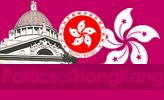 | ||
The Executive Council of Hong Kong (Chinese: 行政會議; Chinese name before the transfer of sovereignty: 行政局) is a formal body of advisers to the Chief Executive of Hong Kong that serves as a core policy-making organ of the Government of Hong Kong. It is analogous to a cabinet or to other executive councils in the Commonwealth such as the Federal Executive Council of Australia, the Executive Council of New Zealand, and the Privy Council of the United Kingdom.
Contents
The Executive Council exists to "advise" the Chief Executive in policy-making and the administration of the government. The Chief Executive acting after consultation with the Executive Council is known as the Chief Executive in Council. The Chief Executive in Council introduces bills to the Legislative Council and issue instruments known as Orders in Council, which amongst other things are used to make delegated legislation, and regulate certain public institutions. The Chief Executive in Council also hears appeals and objections under certain Ordinances.
Under the presidency of the Chief Executive, the Executive Council consists of 16 Official Members (the most senior of these being the Chief Secretary of Hong Kong, head of the Government Secretariat and chair of the Policy Committee), and 14 Non-official Members (normally including leading lawmakers from pro-establishment political parties). The Council normally meets once a week. Unlike the British and Canadian Councils, legislators from the opposition are not appointed to the Executive Council.
History
The Executive Council was set up by the British Hong Kong Government. The first ex officio members were the Colonial Secretary and the Colonial Treasurer in the 1840s. The Attorney General was added in the 1850s. In 1949, the Executive Council had five ex officio members: the senior military officer (Commander of British Forces Overseas), the colonial secretary, the attorney general, the secretary for Chinese affairs and the financial secretary; the Commissioner of Labour, while an 'official' was not an ex officio member. In addition, there were six 'unofficial members': the chief manager of the Hongkong and Shanghai Banking Corporation, the Tai-Pan of Jardine's, a solicitor, two barristers, and a physician.
In 1994 the title 'Senior Member' or 'Senior Unofficial Member' was changed to 'Convenor', when Lydia Dunn was succeeded in the post by Rosanna Wong.
The format of the Executive Council was retained after the transfer of sovereignty in 1997 until a ministerial system (named Principal Officials Accountability System or POAS) was introduced in 2002, Tung Chee Hwa's second term of office. Since then all secretaries are political appointees and have to leave the civil service. All secretaries are appointed to the council, transforming the council effectively into a cabinet. Non-official members are minorities in the council, and are like ministers-without-portfolio. The position of convenor was abolished.
In fulfilling his election platform, Chief Executive Sir Donald Tsang appointed eight new non-official members the day after delivering his first policy address on 12 October 2005. Secretaries of bureaux would sit in meetings of the Council when the agenda was related to their portfolio, and the position of convenor was restored. It was presented as a move to re-strengthen the role of the Council as a link with the community.
Composition
The members of Executive Council are appointed by the Chief Executive from among principal officials (heads of department, informally called "ministers"), members of Legislative Council, and public figures. Their appointment and removal is decided by the Chief Executive. There is no fixed term of office, but the term of office of members cannot extend beyond the expiry of that of the Chief Executive who appoints them (Article 55 of the Basic Law).
The Council is presided over by the Chief Executive. In addition to the 16 principal officials there are 14 Non-official members. Other than the Chief Secretary, Financial Secretary and Secretary for Justice, official members only sit in meetings that are related to their portfolio.
The following list includes all members of the Executive Council in the order of precedence:
Source
List of the past Executive Councils
Location
The Executive Council meets in the Lower Block of the Central Government Complex, Tamar. Until 2012, Exco met in the Main Wing of the Central Government Offices on Government Hill, in Central and below Government House (former residence of the British Governor of Hong Kong).
Prior to the handover, the Provisional Executive Council of Hong Kong, headed by Tung Chee Hwa, met in Shenzhen or Tung's office on the 11th floor of the Asia Pacific Finance Tower in Hong Kong. Members of the outgoing British Hong Kong ExCo were not permitted to attend this body.
Both Executive Council sittings were on Tuesdays.
